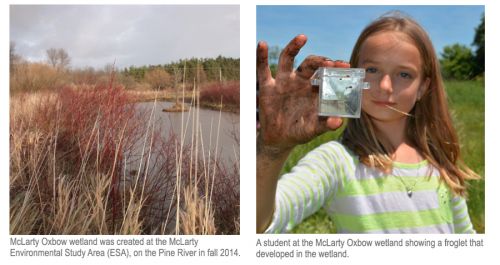Pine River Watershed: wetlands, topsoil, and headwaters

Wetlands are extremely efficient multi-taskers.They filter and purify water, replenish and store groundwater, provide excellent biodiversity and act as natural water retention ponds year-round.
Wetlands also provide an outdoor classroom where students can learn about aquatic ecosystems, wildlife species and the interrelationships involved with a natural environment.
A ‘dirt’y secret
Have you ever wondered why there is such productive farmland in Southern Ontario?
Here’s a hint: it certainly did not happen overnight. In fact, it took millions of years for our rich topsoil to develop.
This painstakingly slow process occurred at the bottom of the many wetlands and lakes that covered this landscape a long time ago. As aquatic plants and other organisms lived, died and decomposed, they left remnants of organic material behind that helped form the nutrient rich topsoil that we depend on today. Our challenge is to look after this precious topsoil, keep it on the land and ensure its continued health for many years to come.
Over the last few years, two projects have been completed in this priority watershed that involved the construction of human-made berms to help keep topsoil on the land and reduce sedimentation in surrounding waterways. It has been estimated that these two berms alone will help keep 100 tons of topsoil on the landscape annually! This is comparable to the weight of nine school buses!
Headwaters: where water meets soil
The function of headwaters is much like the function of our own head, it is the place where decisions are made for the rest of the body, or in this case the rest of the watershed.
The headwaters of any river system are made up of many small trickles of water that might dry up for many months of the year, but act just like the capillaries in our bodies that bring fluid to our major veins and arteries. Like a collector lane full of cars on a major highway, most droplets of water in a river can be traced backwards to a contributing pathway in the headwaters.
It is the health of these headwaters that determines the health of the downstream water bodies, such as the Pine River and Lake Huron.
